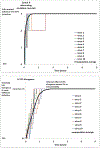Oral poliovirus vaccine evolution and insights relevant to modeling the risks of circulating vaccine-derived polioviruses (cVDPVs)
- PMID: 23470192
- PMCID: PMC7890645
- DOI: 10.1111/risa.12022
Oral poliovirus vaccine evolution and insights relevant to modeling the risks of circulating vaccine-derived polioviruses (cVDPVs)
Abstract
The live, attenuated oral poliovirus vaccine (OPV) provides a powerful tool for controlling and stopping the transmission of wild polioviruses (WPVs), although the risks of vaccine-associated paralytic polio (VAPP) and circulating vaccine-derived poliovirus (cVDPV) outbreaks exist as long as OPV remains in use. Understanding the dynamics of cVDPV emergence and outbreaks as a function of population immunity and other risk factors may help to improve risk management and the development of strategies to respond to possible outbreaks. We performed a comprehensive review of the literature related to the process of OPV evolution and information available from actual experiences with cVDPV outbreaks. Only a relatively small fraction of poliovirus infections cause symptoms, which makes direct observation of the trajectory of OPV evolution within a population impractical and leads to significant uncertainty. Despite a large global surveillance system, the existing genetic sequence data largely provide information about transmitted virulent polioviruses that caused acute flaccid paralysis, and essentially no data track the changes that occur in OPV sequences as the viruses transmit largely asymptomatically through real populations with suboptimal immunity. We updated estimates of cVDPV risks based on actual experiences and identified the many limitations in the existing data on poliovirus transmission and immunity and OPV virus evolution that complicate modeling. Modelers should explore the space of potential model formulations and inputs consistent with the available evidence and future studies should seek to improve our understanding of the OPV virus evolution process to provide better information for policymakers working to manage cVDPV risks.
© 2013 Society for Risk Analysis.
Figures



Similar articles
-
Modeling the dynamics of oral poliovirus vaccine cessation.J Infect Dis. 2014 Nov 1;210 Suppl 1:S475-84. doi: 10.1093/infdis/jit845. J Infect Dis. 2014. PMID: 25316870
-
Modeling the potential role of inactivated poliovirus vaccine to manage the risks of oral poliovirus vaccine cessation.J Infect Dis. 2014 Nov 1;210 Suppl 1:S485-97. doi: 10.1093/infdis/jit838. J Infect Dis. 2014. PMID: 25316871
-
Update on Vaccine-Derived Polioviruses - Worldwide, January 2014-March 2015.MMWR Morb Mortal Wkly Rep. 2015 Jun 19;64(23):640-6. MMWR Morb Mortal Wkly Rep. 2015. PMID: 26086635 Free PMC article.
-
Circulating vaccine-derived polioviruses: current state of knowledge.Bull World Health Organ. 2004 Jan;82(1):16-23. Epub 2004 Feb 26. Bull World Health Organ. 2004. PMID: 15106296 Free PMC article. Review.
-
Molecular evolution of oral poliovirus vaccine strains during multiplication in humans and possible implications for global eradication of poliovirus.Acta Virol. 2000 Apr;44(2):109-17. Acta Virol. 2000. PMID: 10989702 Review.
Cited by
-
Increasing Population Immunity Prior to Globally-Coordinated Cessation of Bivalent Oral Poliovirus Vaccine (bOPV).Pathogens. 2024 Sep 17;13(9):804. doi: 10.3390/pathogens13090804. Pathogens. 2024. PMID: 39338995 Free PMC article.
-
Modeling the spread of circulating vaccine-derived poliovirus type 2 outbreaks and interventions: A case study of Nigeria.Vaccine X. 2024 Mar 16;18:100476. doi: 10.1016/j.jvacx.2024.100476. eCollection 2024 Jun. Vaccine X. 2024. PMID: 38617838 Free PMC article.
-
Trade-offs of different poliovirus vaccine options for outbreak response in the United States and other countries that only use inactivated poliovirus vaccine (IPV) in routine immunization.Vaccine. 2024 Feb 6;42(4):819-827. doi: 10.1016/j.vaccine.2023.12.081. Epub 2024 Jan 12. Vaccine. 2024. PMID: 38218668 Free PMC article. Review.
-
Rapid emergence and transmission of virulence-associated mutations in the oral poliovirus vaccine following vaccination campaigns.NPJ Vaccines. 2023 Sep 25;8(1):137. doi: 10.1038/s41541-023-00740-9. NPJ Vaccines. 2023. PMID: 37749086 Free PMC article.
-
From vaccine to pathogen: Modeling Sabin 2 vaccine virus reversion and evolutionary epidemiology in Matlab, Bangladesh.Virus Evol. 2023 Jul 8;9(2):vead044. doi: 10.1093/ve/vead044. eCollection 2023. Virus Evol. 2023. PMID: 37692896 Free PMC article.
References
-
- Sutter RW, Kew OM, Cochi SL. Poliovirus vaccine-live In: Plotkin SA, Orenstein WA, Offit PA, editors. Vaccines. Fifth ed: Saunders Elsevier; 2008. p. 631–686.
-
- Salk JE. Requirements for persistent immunity to poliomyelitis. American Journal of Medical Science 1956;232(4):369–377 - PubMed
-
- Hammon WM, Ludwig EH. Possible protective effect of previous type 2 infection against paralytic poliomyelitis due to type 1 virus. American Journal of Hygiene 1957;66(3):274–280 - PubMed
-
- Chen RT, Hausinger S, Dajani AS, Hanfling M, Baughman AL, Pallansch MA, Patriarca PA. Seroprevalence of antibody against poliovirus in inner-city preschool children. Journal of the American Medical Association 1996;275(21): 1639–1645 - PubMed
Publication types
MeSH terms
Substances
Grants and funding
LinkOut - more resources
Full Text Sources
Other Literature Sources
Medical

